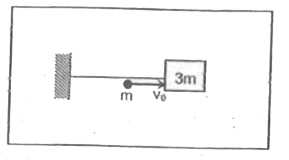Hooke's Law
NA
Similar Questions
A mass (M) attached to a spring, oscillates with a period of (2 sec). If the mass in increased by (2 kg) the period increases by one sec. Find the initial mass (M) assuming that Hook's Law is obeyed.
View SolutionAssume that the least load which would break a thread when simply suspended from it is M and that this load produces a strain of 1 percent at the moment of breaking. Also assume that Hooke's law applies to the thread right up to breakingpoint. A load of mass m is suspended from a thread of length λ. It is raised to a height and released. Find the least height to which the load must be raised so that it will will break the thread when allowed to fall.
View Solution
Knowledge Check
When a person stands on a weighing balance, working on the principle of Hooke's law, it shows a reading of 60kg after a long time and the spring gets compressed by 2.5cm. If the person jumps on the balance from a height of 10cm, the maximum reading of the balance will be
A(a) 60kgB(b) 120kgC(c) 180kgD(d) 240kgWhen a 4 kg mass is hung vertically on a light string that obeys Hooke's law, the spring stretches by 2 cm. The work required to be done by an external agent in stretching this spring by 5 cm will be (g=9.8metrssec2)
A4.900joe–B2.450joe–C0.495joe–D0.245joe–A massless elastic cord (that obeys Hooke's law) break if the tension in the cord exceeds Tmax. One end of the cord is attached to a fixed point, the other is attached to an object of mass 3m as shown in the figure. If a second, smaller object ofmass m moving at an initial speed v0 strikes the larger mass and the two stick together the cord will stretch and break but the final kinetic energy of the two masses will be zero. If instead the two collide with a perfectly elastic one dimensional collision the cord will still break and the larger mass will move off with a final speed of vf. All motion occurs on a horizontal frictionless surface. (Assume that Hooke's law is obeyed throughout untill the cord breaks)

Find the ratio of the total kinetic energy of the system of two masses after the perfectly elastic collision and the cord has broken to the initial knetic energy of the smaller mass prior to the collisionA1/4B1/3C1/2D3/4
State Stoke's law.
View SolutionA massless elastic cord (that obeys Hooke's law) break if the tension in the cord exceeds Tmax. One end of the cord is attached to a fixed point, the other is attached to an object of mass 3m as shown in the figure. If a second, smaller object ofmass m moving at an initial speed v0 strikes the larger mass and the two stick together the cord will stretch and break but the final kinetic energy of the two masses will be zero. If instead the two collide with a perfectly elastic one dimensional collision the cord will still break and the larger mass will move off with a final speed of vf. All motion occurs on a horizontal frictionless surface. (Assume that Hooke's law is obeyed throughout untill the cord breaks)

Find vfv0
View SolutionA copper wire is stretched at a temperature of 150∘C between two strong fixed walls. At what temperature, will the wire break when it cools ? Assume Hooke's law is applicable till the wire breaks.
αCu=1.6×10−5/degree
Ycopper=11.8×1010N/m2
Ultimate strength of copper =2.45×108N/m2
View SolutionIf a spring is extended to length l, the according to Hook's law
View SolutionHook's law defines
View Solution
